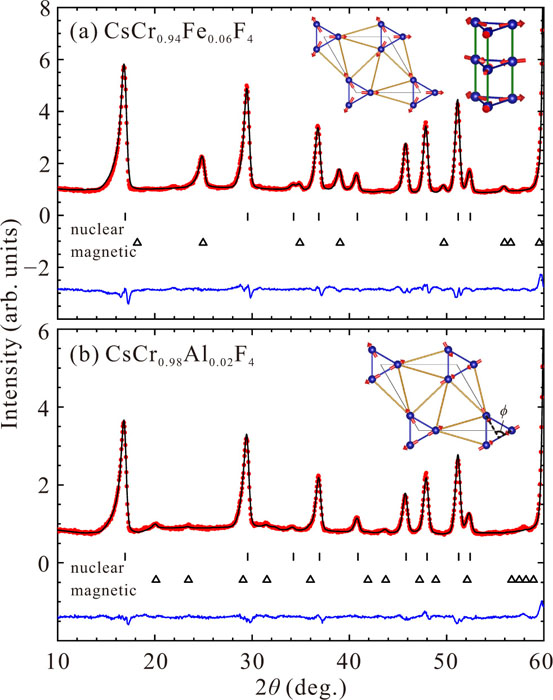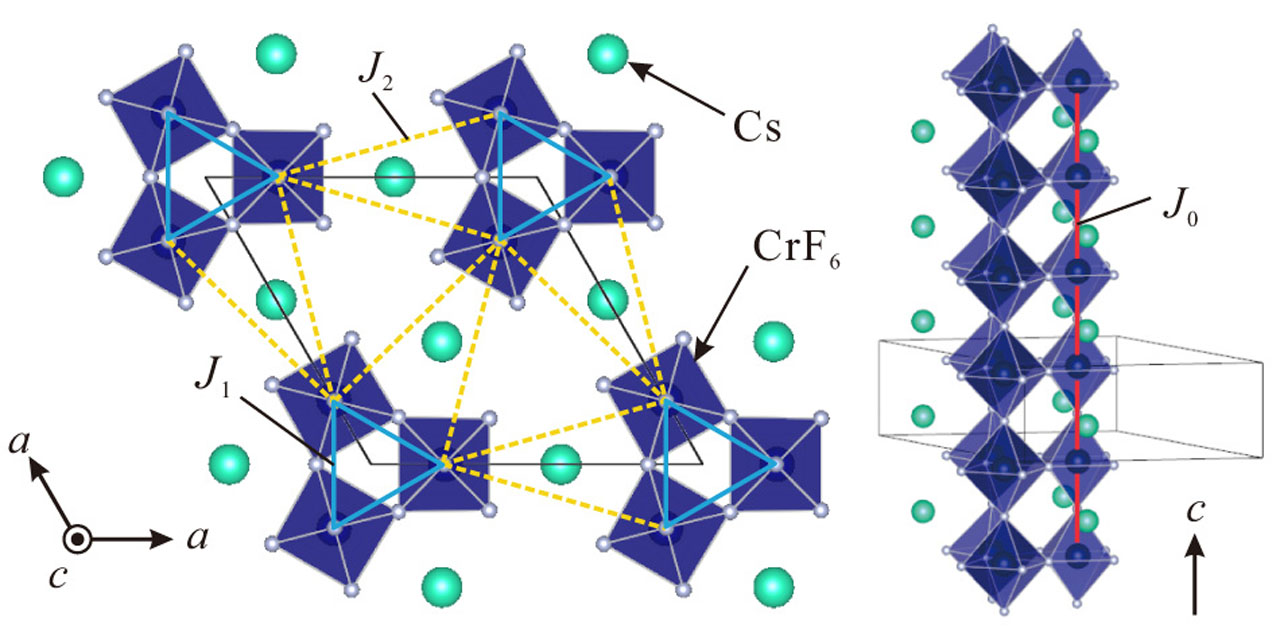Magnetic Order in the Chemically Substituted Frustrated Antiferromagnet CsCrF4
Masuda Group
In geometrically frustrated magnets, macroscopically degenerated ground-states in low-energy regime can be solved by small perturbations. This tells us that magnetic states at low temperatures highlights small effects such as magnetic anisotropy, exchange randomness, and site dilution. These thus play key roles in determining ground states in frustrated magnets. The equilateral triangular spin tube antiferromagnet CsCrF4 [1,2] is a candidate for realizing a ground state sensitive to small perturbations. Magnetic Cr3+ ions having S = 3/2 form triangular spin tubes along the crystallographic c axis, as illustrated in Fig. 1. The tubes couple magnetically with one another and form the kagome-triangular lattice in the ab plane [3]. Neutron powder diffraction study conducted by our group identified long-range magnetic order below 2.8 K [4]. The magnetic moments form a quasi-120° structure in the ab plane. It is unique that the 120° structure propagates antiferromagnetically along the a and c axes with a magnetic propagation vector kmag = (1/2, 0, 1/2). Discussion of ground states in the kagome-triangular lattice model suggested that the ground state of CsCrF4 is close to the boundary on the magnetic phase diagram in the kagome-triangular lattice model [4]. This proposes that small perturbations may induce various types of magnetic states in CsCrF4.
To introduce small perturbations into CsCrF4, we investigate chemical substitution effect. A magnetic Fe-substituted CsCr1-xFexF4 showed long-range magnetic order and enhancement of magnetic anisotropy [5]. In a nonmagnetic Al-substituted CsCr1-xAlxF4, a weak feature of magnetic ordering was observed [5]. Hereby, we report chemical substitution effects on the magnetic ground state in CsCrF4 [6].
We carried out neutron powder diffraction experiments on CsCr0.94Fe0.06F4 and CsCr0.98Al0.02F4. In both compounds, magnetic Bragg peaks indicative of the long-range magnetic order are clearly observed, as shown in Fig. 2. Most strikingly, the magnetic peaks in CsCr0.94Fe0.06F4 are indexed by a propagation vector kmag = (0, 0, 1/2), which is different symmetry from kmag = (1/2, 0, 1/2) in the parent CsCrF4. Magnetic structure analysis identifies that the 120° structure does not alternate in the ab plane, whereas the intratube structure is the same as in CsCrF4. Based on the Goodenough-Kanamori rule on superexchange interactions [7,8], it is predicted that ferromagnetic (antiferromagnetic) interactions between the Cr3+ ions via the F- ions turn into antiferromagnetic (ferromagnetic) interactions by the Fe3+ ion substitution, namely bond substitution. The identified magnetic structure, thus, means that the bond substitution by the magnetic Fe3+ ion modifies the intertube structure, but the intratube structure is intact.

Fig. 2. Neutron diffraction profiles for (a) CsCr0.94Fe0.06F4 and (b) CsCr0.98Al0.02F4 at 1.5 K. Red circles and black curves show the experimental data and simulations, respectively. Vertical bars and triangles indicate the position of the nuclear and magnetic Bragg peaks. Blue curves show the difference between the data and simulations. Insets are the determined magnetic structures.
On the contrary, in CsCr0.98Al0.02F4 the observed magnetic peaks are indexed by the same propagation vector as in the parent CsCrF4. Analyzing the magnetic structure, we find that the spin configuration in CsCr0.98Al0.02 is not changed drastically, even though a relative angle between three spins in the 120° structure deviates more from 120° than that in CsCrF4. Since substituting the Cr3+ ion with the Al3+ ion creates a spin vacancy, trigonal symmetry of the 120° structure is locally broken. However, the spin vacancy only produces a small effect on the ground state of CsCrF4, and therefore the quasi-120° structure is still realized globally in CsCr0.98Al0.02F4.
In conclusion, we have studied magnetic orders in magnetic Fe- and nonmagnetic Al-substituted CsCrF4 through the neutron powder diffraction experiment. The magnetic structure analysis reveals that the Fe-substituted sample exhibits a 120° structure having kmag = (0, 0, 1/2), and the Al-substituted one has a quasi-120° structure having kmag = (1/2, 0, 1/2). Importantly, the magnetic structure in CsCr0.94Fe0.06F4 differs from that in the parent CsCrF4. This result concludes that the ground state in CsCrF4 is more sensitive to magnetic substitution rather than nonmagnetic one on the Cr site.
References
- [1] H. Manaka et al., J. Phys. Soc. Jpn. 78, 093701 (2009).
- [2] H. Manaka et al., J. Phys. Soc. Jpn. 80, 084714 (2011).
- [3] K. Seki and K. Okunishi, Phys. Rev. B 91, 224403 (2015).
- [4] M. Hagihala et al., npj Quantum Mater. 4, 13 (2019).
- [5] H. Manaka et al., J. Phys. Soc. Jpn. 88, 114703 (2019).
- [6] S. Hayashida, M. Hagihala, M. Avdeev, Y. Miura, H. Manaka, and T. Masuda, Phys. Rev. B 102, 174440 (2020).
- [7] J. B. Goodenough, Phys. Rev. 100, 564 (1955).
- [8] J. Kanamori, J. Phys. Chem. Solids 10, 87 (1959).

